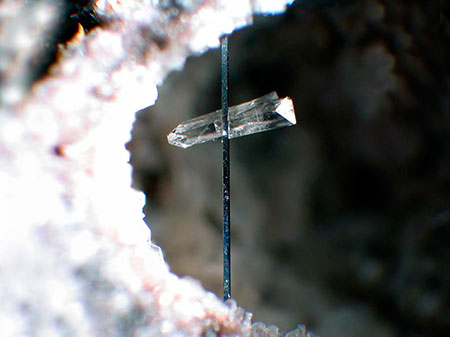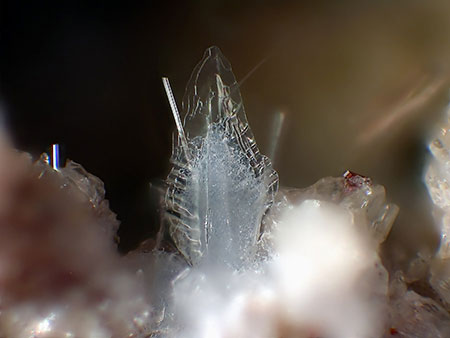
2015.2 | 2015.1 | 2014.2 | 2014.1
2013.2 | 2013.1 | 2012.2 | 2012.1 | 2011.2 | 2011.1 | 2010.2 | 2010.1
2009.2 | 2009.1 | 2008.2 | 2008.1 | 2007.2 | 2007.1 | 2006
February – June 2011
- June 2011 Newsletter – June 2
- April 2011 Newsletter – March 31
- February 2011 Newsletter – February 2
June 2011 Newsletter
In this edition of Pala Mineralis we have quite an aggregate (ouch!): a prince of a featured specimen; shows in France, Munich and Dallas; an off-track trek in Tanzania; small wonders from an Eifel bower; and, er, perfect cleavage.
Shows and Exhibitions
Pala International News
Mineral and Mineralogy News
- A Sapphire Safari in Tanzania
- Un-Minerals in MineralTown
– Note to our newsletter subscribers: We have pulled the above news item.
Please see instead Small Wonders: Diminutive delights from Fred Kruijen
Books
Shows and Exhibitions
Sainte-Marie-aux-Mines: June 23–26, 2011
Pala International’s Bill Larson, Will Larson and Carl Larson, and friend and fellow gem dealer Mark Kaufman will attend this event this year, held in the midst of the Alsace wine region of northeastern France.
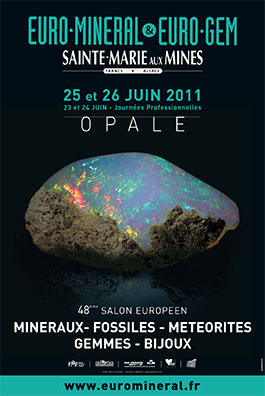 |
To get a taste, see:
- The Larsons’ report for the 2010 show, reprinted from The Mineralogical Record
- Will Larson’s solo report on Day 1 of the show
This year, Euro-Mineral features the special exposition, Les Routes de L’Opale, which will include (if our pidgin French is correct) the reconstruction of an opal mine. Pala International is pleased to contribute specimens to this exhibition.
Also being presented:
- An anthology of French minerals
- The art of micro-mounting
- Mineral wealth of the Val d’Argent
- The fascinating fossil-bearing site of Messel, Germany
- Two 3-D Presentations: Micro-minerals of Vosges and the Black Forest, and Giants of the Naica Caves of Mexico
- Art and Minerals, featuring YKSOS: “Hommage à la Terre,” combining oils and earth in striking abstract expressionism; also the work of German fossil artist Hendrick Hackl and mineral photo-artist Bruno Cupillard
And much more…
What: Euro-Mineral/Euro-Gem
When: June 23–26, 2011
Where: Sainte-Marie-aux-Mines, France
We look forward to seeing you there.
 |
| La bohème. This variety of opal often goes by the name of hyalite and comes from a locality famous for this material, Waltsch (German) aka Vale? (Czech), in the extreme west of the Czech Republic’s Bohemia region. According to Mindat.org, as of 2009 the locality was a “military area” and “natural preserve.” The specimen comes with the German-language labels pictured below and is available: Inventory #15598. (Photo: John McLean) |
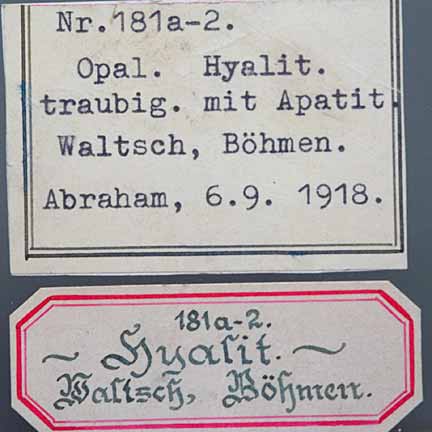 |
[back to top]
BlueCap Looks Back at Munich, Looks Forward to Dallas
What’s Hot In Munich
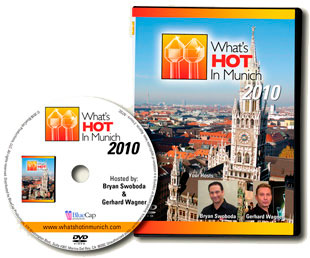 |
Subscribers of The Mineralogical Record got a treat last month, when BlueCap Productions’ new What‘s Hot In Munich DVD was included as a freebie.
If you’re not a subscriber, BlueCap now offers the DVD to the general public.
The Munich show, Mineralientage München, is Europe’s oldest mineral show, and last fall featured a collection of Brazilian tourmalines from the Pederneira Mine—for the first time.
Friends of Pala International get a 10% discount on any BlueCap order. Just enter the code palaintl when you’re asked for it while ordering.
What’s Hot In Dallas
Last summer, mineral purveyor Rob Lavinsky held an event to mark the opening of his new Arkenstone gallery in Dallas. That informal event has developed into an annual meeting, the Dallas Mineral Collecting Symposium, co-hosted by the Mineralogical Association of Dallas and Southern Methodist University’s Department of Geology. The event is scheduled for Saturday, August 27. Topics and speakers:
- Museum Activities: Collections, Curation, and Philanthropy
- Dr. Jeffrey Post of the Smithsonian’s Museum of Natural History, Dr. Joel Bartsch of Houston Museum of Natural Science, and
Marc Wilson of Carnegie Museum of Natural History
- Dr. Jeffrey Post of the Smithsonian’s Museum of Natural History, Dr. Joel Bartsch of Houston Museum of Natural Science, and
- Tax Implications of Philanthropy and Donations to Museums
- Hon. Francis Allegra, Federal Judge and legal columnist for The Mineralogical Record
- The Science Behind Collectable Gem Crystals
- Dr. Barbara Dutrow, Louisiana State University and
Dr. George Rossman, Caltech
- Dr. Barbara Dutrow, Louisiana State University and
BlueCap Productions was there last year and offers the DVD Dallas Mineral Symposium: 2010. Presentations were by collector and author Gene Meieran (Senior Intel Fellow) and Apollo 17 astronaut Harrison Schmidt (first geologist to walk on the moon). [back to top]
Pala International News
Pala’s Featured Specimens: Black Spinel and
Golden Topaz from Burma
This month we feature a couple of new jewels from Bill and Will Larson’s trip to Bangkok and Burma: a black spinel from Pein Pyit and a golden topaz from Sakangyi, both localities in Mogok.
Black Spinel from Pein Pyit, Mogok
The spinel is a completely unique specimen, drawing these words from Bill, who has had 30-plus trips to Burma: “I have never seen anything like it.” In most lighting, the piece is a jet-black spinel embedded in pure white calcite, which makes for a very dramatic specimen. With transmitted light the spinel has an intense reddish-purple hue. The crystal exhibits the classic octahedral shape, with rounded edges and smooth, glassy faces.
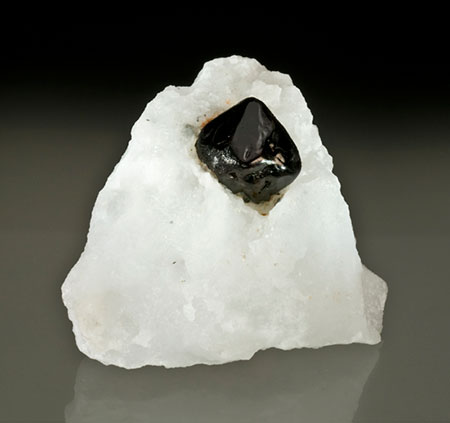 |
| The Prince’s Black Spinel. Specimen 7.3 x 8 x 5.5 cm.; crystal 2.5 x 2 mm. (Photos: Jason Stephenson) |
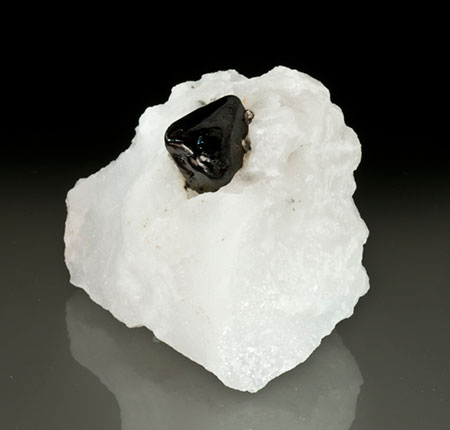 |
Golden Topaz from Sakangyi, Mogok
The topaz is a spectacular gem sure to impress veteran and novice collectors alike. The color shifts from peach to cognac as you fumble it around in your hands. You even pick up some interference-colors flashing off of the internal features. It has a beautifully symmetrical crystal form with sharp edges and glassy faces. There is some damage on the bottom, but it hardly takes away from the impressive feel of the crystal.
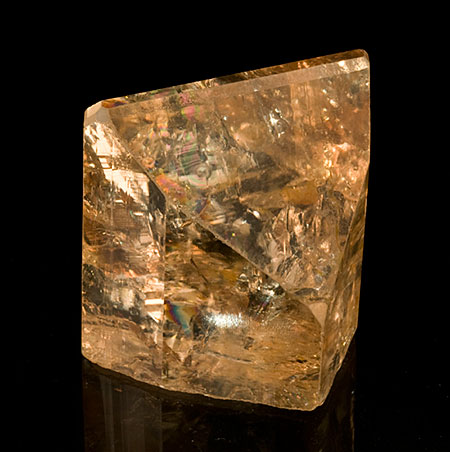 |
| Golden topaz, 8.5 x 7 x 6.2 cm. (Photos: Jason Stephenson) |
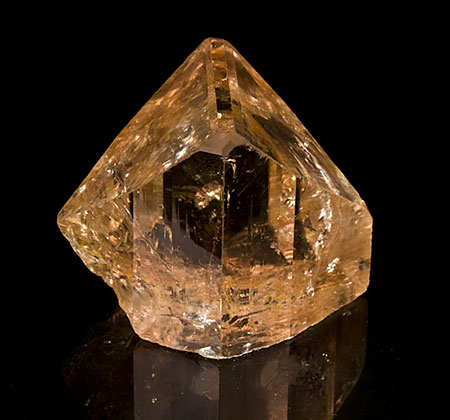 |
For more on topaz, see below.
Mineral and Mineralogy News
A Sapphire Safari in Tanzania
Insane Gem Posse roves the land
Visitors to Richard Hughes’s Ruby-Sapphire.com and Vincent Pardieu’s FieldGemology.org already may be familiar with accounts of their visit (with fellow traveler–coauthors) to Tanzania in October 2007. Nine months later, Hughes posted this Insane Gem Posse’s (his term) “Working the Blueseam: The Tanzanite Mines of Merelani.” For our readers not yet in the know, we point to “Downtown: Gem Hunting in Central & Southern Tanzania,” the team’s companion piece on the expedition posted by Hughes a few days ago.
Lest we need reminding, this is field gemology. In the earlier installment, a visit to one artisanal tanzanite mine—and its 100-meter drop and 200–300-meter wormhole—led the volunteering by at least one or two of the authors to remain up top, “ever vigilant,” should a doctor need to be summoned in case of accident. In “Downtown,” the authors narrowly missed rioting and car-burning in Mahenge before their visit, and a show-stopping mining dispute a few days after. Oh, and a mob with sticks and stones in Tunduru.
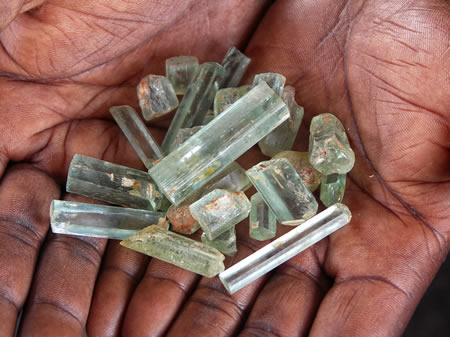 |
| Aquamarine from Namtumbo, on the road between Songea to Tunduru. (Photo: Vincent Pardieu) |
While the group’s original destinations were the corundum deposits of Songea and Tunduru in the south, as luck would have it two months before their arrival, huge red spinel crystals were found farther north, at Mahenge. And there was plenty more to see—and not to see—along the way: the Morogoro region, which had produced ruby and spinel beginning in 1986, had no activity 21 years later, but a Morogoro dealer showed them some of the spinel from Mahenge, whetting the appetite for more. And a visit to nearby Gongoni and its “moonstone” (aka peristerite) mine turned up, well, low grade corundum.
Upon their arrival at Mahenge, the travelers were told they had missed, by only a few days, rioting by local miners who had been banned from a property by a mining interest that held bogus credentials. That night, the pilgrims also heard of spinel crystals going for three times the normal rate. En route to the mining site the next day, they passed ruby localities that had peaked in the 1980s and ’90s, where small-scale operations continued. And, finally, to the “Joel Box,” named after the miner who discovered the first spinels there. The huge crystals, found just two months before, were giants of 52, 28, 20, and 5.7 kilograms, yielding clean cut stones ranging from 10 to almost 50 carats. The Posse visited the operation at that spot with impeccable timing: a mining rights dispute shut it all down just a few days later. (Some lucky miners moved on to Winza and its “ruby rush.”)
 |
| Weathered marble outcrops near Mahenge, dwarf the spinel diggings. The formations—and the gems they produced—reminded some expedition members of the Mogok Stone Tract of Burma. (Photo: Richard Hughes) |
From Mahenge, the crew traveled to Songea, and the article documents well the geology, outback-mining and “downtown”-dealing of the region’s sapphire, as it does the activity of Tunduru, famous in the mid-1990s for sapphire, ruby, alexandrite, and chrysoberyl. During their time there, the visitors found all of the above as well as topaz, quartz, garnet (and tsavorite), spinel and diamond. Oh, and safari ants.
Read “Downtown: Gem hunting in Central & Southern Tanzania” at Ruby-Sapphire.com.
See also the report on which “Downtown” is based—Pardieu’s “Tanzania, October 2007: A Gemological Safari” for more photos and streaming video.
An added treat, also at Ruby-Sapphire.com, is a newly revised version of expedition member Warne Chitty’s 2009 Bachelor of Science dissertation, “A Study of Sapphires and Rubies from Tanzania’s Tunduru District.” Thirty-two pages illustrated with over forty figures. [back to top]
Small Wonders
Diminutive delights from Fred Kruijen
Fred Kruijen has a website devoted to The Wannenköpfe, a quarry in Germany’s western Eifel Region. His photographs (some of which appear to be in-situ) document the achingly delicate nature of Nature. We pulled two samples from Kruijen’s section at Wikimedia Commons:
[back to top]
Books
Topaz: Perfect Cleavage
A monograph from Lithographie
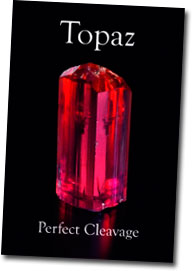 |
The fourteenth edition in German publisher Lapis’s mineral series, on topaz, includes contributions by Dudley Blauwet, Dave Bunk, Ryan Bowling, Jaroslav Hyrsl, H. Albert Gilg, Alfredo Petrov, John Rakovan, Rainrer Thomas, William B. Simmons, and George Rossman. It is edited by Gloria Staebler, Sarah Hansen, Sue Liebetrau, and Janet Clifford. It includes illustrations by Jeff Scovil, Robert Weldon, Ryan Bowling, and Harold and Erica Van Pelt.
The following comes from German publisher Lapis, whose domestic affiliate Lithographie publishes the series from which comes Topaz: Perfect Cleavage.
Entry #14 in the ExtraLapis English series of softcover, magazine-format books is entirely devoted to the wonders of topaz, one of the most popular and collectible of all gem species.
Introductory chapters cover general mineralogy, historical lore and geology, followed by a series of beautifully illustrated chapters on important topaz occurrences: (1) the Maynard mine in the Thomas Range, Utah, (2) Volodarsk-Volynski in Ukraine, (3) Japanese occurrences, (4) Colorado occurrences, (5) Mongolian occurrences, (6) Gilgit-Baltistan, Pakistan (including an excellent locality map), (7) St. Anne’s mine in Zimbabwe, (8) Brazilian occurrences, and (9) Russian occurrences.
Concluding chapters deal with color in topaz, David Brewster’s experiments with topaz, inclusions in topaz, and cat’s eye and star topaz. Three pages of references are provided at the end. Beautifully illustrated in color throughout, as is typical for the series.
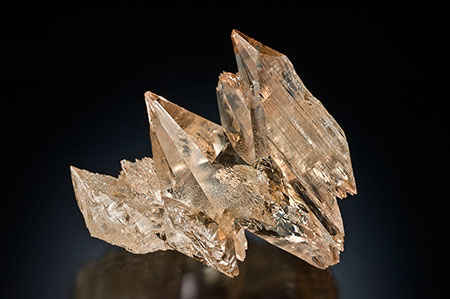 |
| Naturally etched topaz group, 5.6 cm. wide. Haiderabad, Shigar Valley, Skardu District, Gilgit-Baltistan Province, Pakistan. Included in Topaz: Perfect Cleavage, p. 52. Click to enlarge. (Bill Larson collection; Photo: Jeffrey Scovil) |
The book is available from Lithographie, publisher of the mineral monograph series, and other booksellers. [back to top]
— End June Newsletter • Published 6/2/11 —
April 2011 Newsletter
In this edition of Pala Mineralis we look back at Tucson and look at two upcoming: one in the hometown of Mitch Miller, the other in the rodzinnym of Martin Moller. We feature two lovely specimens in somewhat complementary colors and ogle two remarkable gold nuggets. BlueCap Productions looks at three thumbnail collectors/collections and Pala’s Jason Stephenson looks at an important book on Brazilian minerals and gemstones. Lastly, we call your attention to efforts put forth by the gemstone community to aid the people of New Zealand and Japan.
Shows and Exhibitions
- Tucson Torrid — Despite the Icicles
- 38th Rochester Mineralogical Symposium: April 14–17, 2011
- Mindat.org to Hold First International Conference: July 10–17, 2011
Pala International News
Mineral and Mineralogy News
Books
- Minerals & Precious Stones of Brazil
by Carlos Cornejo and Andrea Bartorelli
Reviewed by Jason Stephenson
Shows and Exhibitions
Tucson Torrid — Despite the Icicles
In the introduction to February’s edition of our e-newsletter, we wrote,
At the time of this edition of Pala Mineralis Tucson show attendees are enjoying an escape from the severe weather that grips the Midwest to the East Coast. We wish all our snowbound friends the best.
The next day, Pala’s Bill Larson sent us this photograph, taken on the grounds of the Westward Look resort, which was preparing to host its famous show:
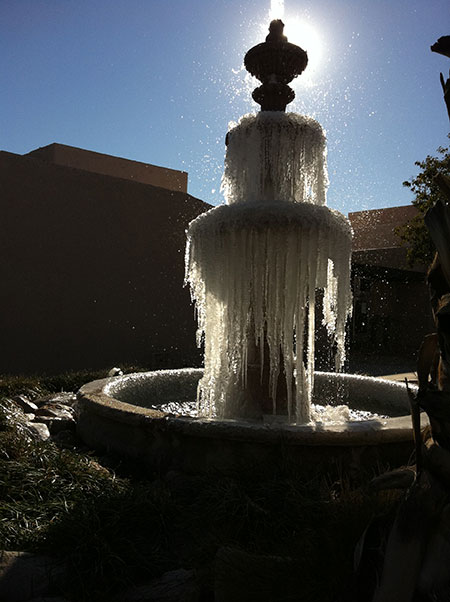 |
But if things were frosty outside, they were sizzling inside at the America Gem Trade Association (AGTA) GemFair. “We had a ‘Monster’ show,” Pala’s Gabrièl Mattice told us. “It was so nice to feel an enthusiastic mood from everyone—dealers and customers alike.” Indeed, AGTA reported last Thursday that, despite the weather that kept some would-be attendees homebound, “[b]uyer attendance was up 5% over 2010, building on a 7% increase from the previous year.” AGTA CEO Douglas T. Hucker raved that “the real success of the show was the atmosphere on the show floor, with a significant upswing in buying activity.”
Rose Marques, from the Tucson Gem and Mineral Society, told us that their show’s attendance has remained steady for the last two years—over 18,000. “We did receive a lot of positive feedback from our dealers at the 2011 Show about their sales,” she said.
 |
| Twinning at Tucson. Our friend Elise Skalwold accompanied John and Kristi Koivula on an “inclusion quest” during which they picked up a real treasure—a specimen with quartz inclusions each of which exhibits fantastic Brazil Law twinning. The above image shows just one of the many inclusions’ “starburst” displays. See more at nordskip.com, where you’ll also find a link to beautiful images of the same phenomenon in ametrine. (Photomicrograph: Elise Skalwold) |
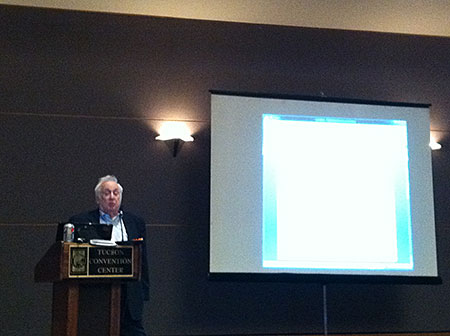 |
| Gene Meieran sets up for the meeting of a new, and as yet unnamed, mineral organization February 12 in Tucson. Beginning his collecting in 1949, in his father’s Norway, Meieran for the last twenty-some years has specialized in “high-quality gem species and native element crystals,” according to his profile at The Mineralogical Record. While a graduate student at MIT, Meieran rescued two large topaz crystals from being cut for use in X-ray monochromators; the crystals now are in the Smithsonian’s collection. Meieran contributed the afterword to American Mineral Treasures. (Photo: Bill Larson) |
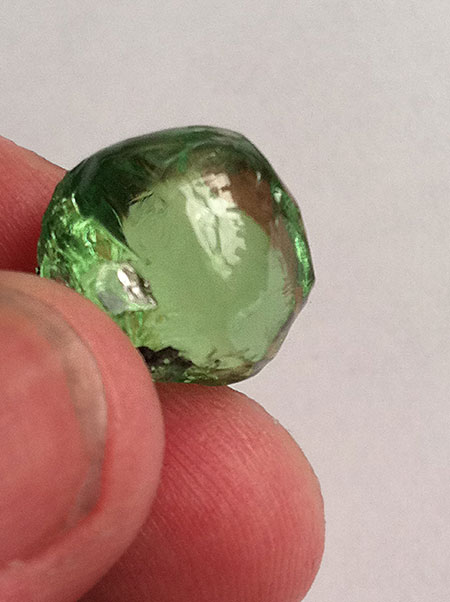 |
| From the Emerald Aisle at Pala International’s booth at Tucson, this 26-carat garnet nodule from Tanzania was acquired by a lucky buyer. (Photo: Bill Larson) |
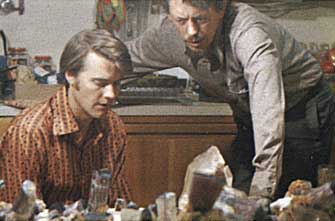 |
| Pala’s Bill Larson spoke on the 12th to a packed house at the Tucson Gem and Mineral Show on the topic of “Fabulous Treasurers [sic] from San Diego Gem Mines.” The image above depicts Bill (left) with Dr. Vince Manson, then curator of the American Museum of Natural History, examining tourmalines from the Tourmaline Queen find in 1972. |
Photos. And more photos.
For a tramful of photos from the Tucson shows, you must visit these threads on FMF Mineral Forum:
- Look through Gail Spann’s viewfinder, including the Minerals of Pakistan and Afghanistan event at the U of A and Federico Pezzotta’s presentation (scroll down two) on Madagascar at Westward Look, and…
- …catch the Pala people on the second page at the saloon of Wayne and Dona Leicht, and…
- …see how Gail serves up the Wutong Princess, purchased at Tucson
- …and how Bill Larson gets personal with Victor Yount
- Read the thoughts of Jordi Fabre, to which he allows others to contribute…
- …including Matt Zukowski, who posted amongst other things two views of a gorgeous Elmwood fluorite with “Carthage corners” from Donald K. Olson
[back to top]
38th Rochester Mineralogical Symposium: April 14–17, 2011
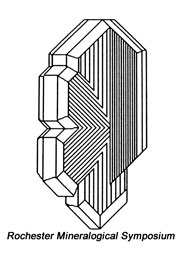 |
Elise Skalwold, of Cornell University, reported to us on the awarding at Tucson of the 2010 Carnegie Mineralogical Award to the Rochester Mineralogical Symposium. The Symposium was represented at the presentation by Steve Chamberlain and Bob Morgan. Past honorees and recipient photos are listed here.
The 38th Rochester Mineralogical Symposium roster includes:
- Dr. Renato Pagano on the Camillo Gualteroni Collection
- Dr. Robert Martin on diverse phlogopite deposits
- William deLorraine on the Balmat zinc deposits of New York State
- Dr. Georg Gebhard on collecting a classic European localities
- Jeff Scovil on what’s new in minerals
- Justin Zzyzx on the application of mineralogy to detect fraud
- Ted Johnson on minerals of the Tilly Foster Iron Mine in southeast NY
- Rainer Bode on the terra mineralia Collection in Saxony
- Dr. Sarah Hanson on northern Arizona volcanic eruptions
The two Technical Sessions will feature two dozen brief presentations. Elise noted two in particular.
- John Rakovan’s discussion of spiral inclusions in crystals (see an incredible example by John Koivula pictured here), and
- A look at hollow galena from Madan, Bulgaria, by Lance E. Kearns and Jessica S. Simonoff—who is an award-winning 12-year-old
| Pala reported on this Saxony collection in October 2008; it is the subject of Rainer Bode’s presentation at the symposium in Rochester and another talk at Mindat.org’s conference. |
For more information, visit the Rochester Academy of Science website. [back to top]
Mindat.org to Hold First International Conference
Conference scheduled July 10–17 in tandem
with local Ste-Marie-like fest
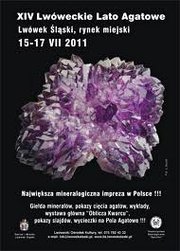 |
| The Mindat.org conference takes advantage of nearby mineral localities in southwest Poland, and an annual festival. |
Thanks also to Elise Skalwold for alerting us to the 1st International Mindat.org Conference to be held in Poland, July 10–17, 2011.
The conference is timed to coincide with the town of Lwówek Śląski’s exhibition, Lwóweckie Lato Agatowe. Apparently it’s the Lower Silesia’s answer to Sainte-Marie-aux-Mine’s Euro-Mineral/Euro-Gem, according to Jolyon Ralph’s illustrated report on the 13th annual event last July.
The week’s schedule begins with field trips to three agate localities, several granite quarries, and the Lubin copper mines, followed by two full days of conference and then two days of short presentations and workshops. Presenters hail from Brazil, Germany, Italy, Poland, Slovenia, U.K., and U.S.
And congratulations to Jolyon Ralph for receiving the Mineralogical Society of America’s Distinguished Public Service Medal for 2011. [back to top]
Pala International News
Pala’s Featured Specimens: Foreign and Domestic
This month we feature a couple of items that are new to the Pala catalog.
Copper in Calcite from Keweenaw Peninsula, Michigan
First up is an amazing copper in calcite from the Keweenaw Peninsula in Michigan. It has a beautiful scalehedron structure, a massive white calcite in the core and a clear outer layer including the peak of the crystal, which is transparent. The center layer is a brilliant copper phantom that scintillates in the light.
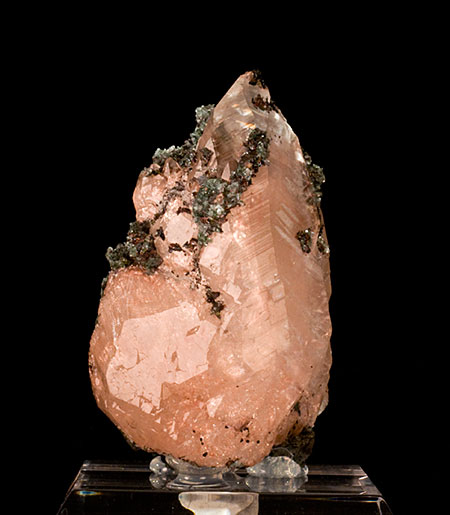 |
| Copper in calcite, Keweenaw Peninsula, Michigan, 8.0 x 5.5 x 4.5 cm. Price available upon request. (Photo: Jason Stephenson) |
With impressive size, shape and color this specimen is definitely an icon in the mineral world. No damage, no repairs, just a pristine beauty.
This specimen was collected by Ben Williams’s father, John Williams, in the 1860s. During this time period the elder Williams worked at the copper smelter in Hancock, Michigan. Ben would have been a young teenager at the time. These pieces were likely passed on from father to son and pre-date Ben’s arrival at Bisbee, Arizona by about 15 years.
Most of these copper-in-calcites came out in the 1800s and early 1900s. The two main mines that produced this rare blend were the Quincy Mine and the Franklin Mine around Hancock, Houghton Co., in Michigan.
See more on Keweenaw Copper District in the current edition of Rocks & Minerals (courtesy of last year’s Rochester Mineralogical Symposium).
Tanzanite from Merelani, Tanzania
This month we also must mention a superb tanzanite crystal from Merelani in Tanzania.
 |
| Tanzanite from Merelani, 39 grams, 4.7 x 2.5 x 1.8 cm. Inventory #19089. (Photo: John McLean) |
This is an exquisite prismatic crystal with perfect form and—like our other featured specimen—in pristine condition. All the crystal faces are well defined and lustrous, encasing a seemingly flawless crystal. Its completely natural color includes strong trichroism of blue and purple, along with red seen down the c-axis. Most of the inside is very gemmy and could literally be fashioned into a large faceted stone.
The desire for fine tanzanite crystal specimens has finally made its way into the minds of the miners. More care is now being taken to pull them out of the ground in order to preserve them in the rough. Part of this shift in thinking may be due to the softening of the faceted tanzanite market. Calls for cut stones are on the decline while crystal hunters are now on the prowl. Luckily we on the mineral collector end are thus seeing a wider selection of material and some of the finest tanzanite crystals to be unearthed.
Pala purchased a small but choice selection of fine crystals earlier this year. Click here to see our new tanzanite specimens.
Interested? Call, select the inventory number above, or email us to inquire. [back to top]
Earthquake Response: Lighting up like a gem
Earlier this month, in our sister publication, Palagems Reflective Index, we made appeals to aid the people of New Zealand and Japan following their devastating earthquakes. We pointed to the creativity of NZ gem and jewelry appraisers who were donating a day’s fees to the Red Cross, and holding “Valuation Saturdays”—à la Antiques Road Show—with all appraisal proceeds from the events benefiting the cause.
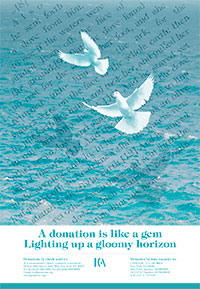 |
Soon after our newsletter was released, an urgent call was emailed to Ambassadors of the ICA (International Colored Gemstone Association) around the globe, asking volunteers to open their homes to at-risk Japanese families in order to escape radiation effects. This was followed shortly by an email forwarded by a second writer who two days before had made a similar, private appeal to his own circle. “You know me personally as a friend,” the writer had told them. “Therefore I am not afraid to raise this crazy idea with you.” In the end, after consultation with contacts in Japan, the effort was deemed “deeply touching” but premature. The gesture, however, shows the lengths to which the gemstone community was willing to go. (Indeed, several responses were received to the initial email, offering to host multiple families until the crisis abates.)
Yesterday, ICA issued a separate call for donations.
ICA has decided to open a donation channel and let all of us who would like to help – donate a sum of money that will be collected by ICA Head Office and donated on behalf of ICA by the ICA Board of Directors.
The decision on which charities and countries will receive the donations will be taken during ICA General Assembly at the ICA Congress in Rio de Janeiro.
The downloadable poster shown above has details on exactly how checks and wire transfers can be facilitated.
Pala’s Will Larson has a special relationship with Japan, as we noted in a profile in October 2009. In the appeal we made this month, he shares his reaction to the crisis.
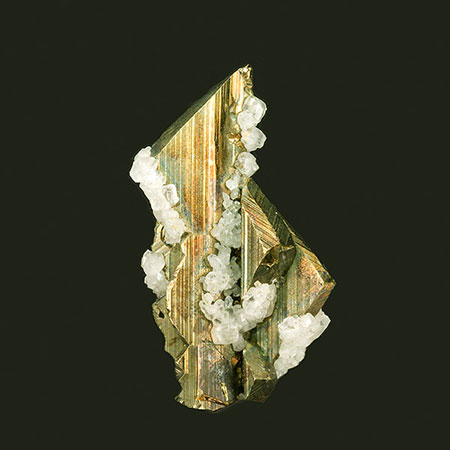 |
| Chalcopyrite, Arakawa Mine, Ugo (Akita Prefecture), Japan. While in Gene Meieran’s collection this specimen won the Lidstrom award at Tucson. From Will Larson’s Japanese collection. (Photo: Mia Dixon) |
[back to top]
Mineral and Mineralogy News
Going for the Gold
Washington Nugget Sells for $400,000
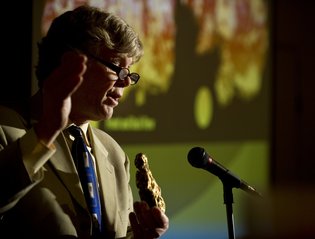 |
| Auctioneer Fred Holabird tells of the Washington Nugget's history before the bidding. (Photo: Andy Alfaro, courtesy Sacramento Bee) |
The Washington Nugget, which we profiled in our last newsletter, was sold at auction in Sacramento March 16 for the upper end of its estimate, $400,000, according to a detailed account in The Sacramento Bee. The winning bid was made on behalf of an anonymous client by Irvine’s Spectrum Numismatics International. The firm’s Richard Melamed was on the phone with the buyer, according to CoinNews.net, as the bidding progressed. The story mentioned a string of historic collectible transactions facilitated by Spectrum, which are listed on this page from its website. The buyer’s premium brought the price to $460,000. Following the auction, the nugget was displayed at the American Numismatic Association’s National Money Show in Sacramento. According to auctioneer Fred N. Holabird, the nugget was found in an unmined section of the Omega-Malakoff Channel, the famous “blue lead” Tertiary channel, in California’s Nevada County.
Ausrox Nugget Displayed at Tucson
The Ausrox Nugget comes from its own famous locality—Kalgoorie-Boulder, Western Australia—which bills itself as the country’s Gold Capital. (The local newspaper is called the Kalgoorie Miner.) On September 1, Dutch writer and filmmaker Jeroen van Bergeijk—currently writing about his own gold prospecting in Western Australia—broke the news about the Ausrox rock on his blog. Near the end of a late-August annual meeting of gold prospectors at a 100-year-old inn at Ora Banda, a gold buyer from Perth made an announcment. Andy Comas, director of Ausrox Gold, said he’d bought and sold a 23.26-kilogram nugget, which had been discovered in the local goldfields with a metal detector (in April 2010, per the Melbourne Museum). Van Bergeijk wrote that the nugget was 92% pure and worth… well, you’ll want to read the rest of the blog entry.
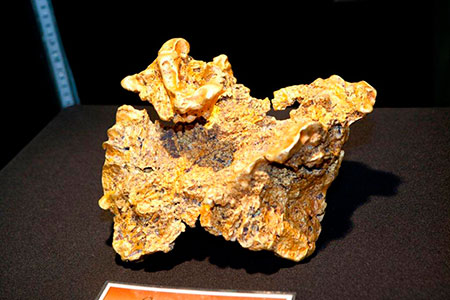 |
| The Ausrox Nugget was on display at this year’s Tucson Gem and Mineral Show. |
Mother Lode Gives Birth at 163 Years Old
Several companies are looking towards a renaissance in the mining of California’s Mother Lode. One such firm, Colorado’s Sutter Gold Mining, Inc., owns a 3.6-mile stretch of the vein in the Sierra Nevada, according to a February 12 article in the New York Times. Sutter Gold has done the permitting to allow it to begin mining as early as 2012.
The article discusses environmental challenges, which concern the removal of toxic chemicals left from previous mining as well as the consequences of project abandonment. One company, Emgold Mining Corporation, pledges to treat water prior to its return to the local waterway, and to turn some waste rock into tile.
Gold presently is at a near-all-time high of over $1400 an ounce. “The price is there,” the Times quoted James Hesketh, head of Colorado’s Atna Resources, which has the open-pit Briggs Mine operating in Inyo County, apparently near Death Valley and Fort Irwin. Sutter Gold’s underground Lincoln Project falls within within a ten-mile stretch from Jackson to Plymouth, in Amador County, that could have a gross gold production of nearly 8 million ounces, according to this illustration on its website. [back to top]
BlueCap Takes a 360-Degree
Perspective on Thumbnails
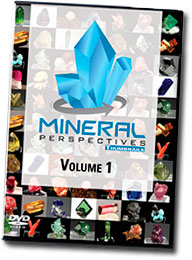 |
At Tucson this year, BlueCap Productions debuted the first in a news DVD series: Mineral Perspectives. The idea is to let viewers inspect specimens “in the round,” with all aspects included.
This series takes us “into the homes and collections of some of the most respected figures in the mineral world,” according to the BlueCap website. The first in the series focuses on nearly 60 thumbnail specimens from the collections of
- Carolyn Manchester, who has collected her award-winning specimens for over 55 years,
- Wendell Wilson, best known as editor of Mineralogical Record, and
- Rich Olsen, who BlueCap describes as a “philanthropist and museum activist”
The host, Jim Houran, related his excitement about the project in a series of posts on FMF Minerals Forum.
Friends of Pala International get a 10% discount on any BlueCap order. Just enter the code palaintl when you’re asked for it while ordering.
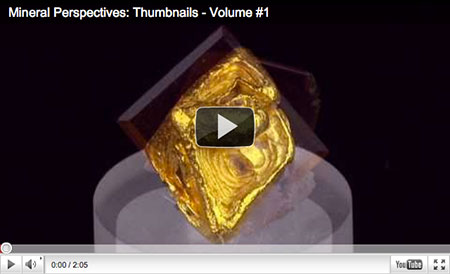 |
| Click above for an introduction to Mineral Perspectives: Thumbnails on YouTube. |
[back to top]
Chips & Chunks
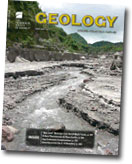 |
Cave-cicles a key to climate change?
A two-year-old Danish study established a relationship between the Earth’s magnetic field, weather patterns and climate change. The conclusion was drawn after reconstructing the magnetic field of 3000 BCE using data “drawn from stalagmites and stalactites found in China and Oman,” as reported by Agence France-Presse and Vidensab dk on January 12, 2009, and picked up this February 4 by an overview of the subject on Helium.com.
The Geological Society of America’s journal Geology published the findings by Mads Faurschou Knudsen of Oxford University and University of Copenhagen and Peter Riisager of the Geological Survey of Denmark and Greenland. The two claim that the magnetic field is but “one of several factors [that] have influenced certain aspects of the climate in certain areas,” such as cosmic radiation—a theory put forward by Henrik Svensmark as early as 1997. These theories enhance—or detract from—the more common greenhouse-gas link to climate change.
Rocks & Minerals goes to San Diego County
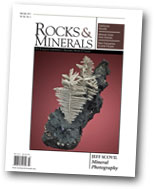 |
In its January/February 2011 issue, Rocks & Minerals visited several San Diego County landmarks.
- The Oceanview Mine, which we have kept up with in our own pages,
- Mines and Minerals of the Southern California Pegmatite Province,
- The Fallbrook Gem and Mineral Museum, and
- Byron Carroll Weege (1940–2010), Pala, California
See also the current R&M (pictured above) for “The History of Kunzite and the California Connection.”
Thomas P. Moore’s column goes portable
Thomas P. Moore, who is seen in many a Tucson photo with pen-and-pad in hand, has a new format for his online column at Mineralogical Record, “What’s New in the Mineral World”: PDF (portable document format). It means many of the images, customarily sprinkled throughout, are higher resolution than via the previous HTML format. And you can download them for future reference.
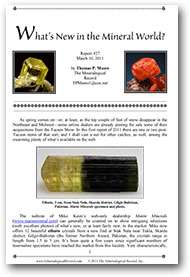 |
[back to top]
Books
Minerals & Precious Stones of Brazil
by Carlos Cornejo and Andrea Bartorelli
Reviewed by Jason Stephenson
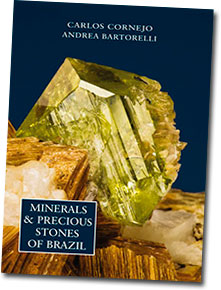 |
Minerals and Precious Stones of Brazil is the first comprehensive book on all of the wonderful and varying deposits that produce gem materials in this vast country: from the historic diamond deposits of Bahia, to the plethora of gem- and metal-producing deposits in Minas Gerais, to the recent discovery of copper-bearing tourmaline in Paraíba. Brazil was once the world’s leading producer of gold; now it is the leader in production of iron ore, tin and niobium. Brazil also leads in production of gem minerals like tourmaline, quartz and beryls. This book reveals great insight into mining and mineralogy as they have evolved in Brazil.
Historic and gemological references in the text, complemented by flawless, colorful pictures, run throughout the 704 pages. The beautiful color plates on every page depict some of the great mineral specimens found in Brazil, along with many images of mining localities and the people involved. The book is organized in 175 mini-chapters, and profiles the characters involved with mining—from pre-Columbian native peoples to current operations. This books visits each mineral found in Brazil, species by species, mine by mine. Minerals and Precious Stones of Brazil is your new encyclopedia on Brazil’s natural treasures.
This book is sponsored by Vale, a mining company headquartered in Brazil with over 100,000 employees. Although large-scale mining operations are important for the mass of materials used for our daily lives, it is noted that most mineral specimens are the result of arduous care by small claims. The collection and documentation of all the minerals portrayed in this book are important scientifically to our understanding and eventual wealth.
A couple of noteworthy quotes from the book’s coauthor, Carlos Cornejo:
This book formed gradually like a crystal, incorporating, page by page, extraordinary mineral treasures and true masterpieces of Nature.
…precious stones and minerals as natural aesthetic products…as subjects of cultural interest…to be protected so that future generations can contemplate irreplaceable legacy of nature.
The book can be ordered in the U.S. from Lithographie LLC. A PDF overview also is available, which includes ordering information for a Portuguese language version. [back to top]
— End April Newsletter • Published 3/31/11 —
February 2011 Newsletter
At the time of this edition of Pala Mineralis Tucson show attendees are enjoying an escape from the severe weather that grips the Midwest to the East Coast. We wish all our snowbound friends the best. At the shows we will feature some great California kunzite fresh from the mine, and Pala’s Bill Larson’s Tucson talk will highlight tourmaline from the Golden State (where a rare nugget will be auctioned next month). And, as always, there’s more (below and at the shows), from around the country and around the globe.
Shows and Exhibitions
Pala International News
Mineral and Mineralogy News
- From the Woman’s Club to Petroleum Club: Classy Dallas
- Going Down the Tubes: A second look at “agate fingers” from Central Java
- Washington Nugget the Last of Its Breed
Books
- Russian Alexandrites by Karl Schmetzer
Reviewed by Lisbet Thoresen - Terra Spinel – Terra Firma
by Vladyslav Y. Yavorskyy with Richard W. Hughes
Shows and Exhibitions
Tucson Time – February 1–13, 2011
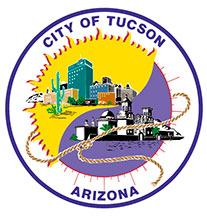 |
The tragic and heroic events of Saturday, January 8, have put a different sort of spotlight on Tucson, home of the world’s greatest gem and mineral show. With last Tuesday’s memorial, the nation—in a virtual way—came together with the people of Tucson to express condolences. Next month, the gemstone and mineral community will have a timely opportunity to do the same—in person…
Show Schedule
See the links below on Palaminerals.com for Pala International’s location at the following Tucson venues, and for other show details.
- AGTA GemFair – It’s AGTA’s 30th Anniversary! – February 1–6
- 10th Annual Westward Look Mineral Show – February 4–7
- 57th Annual Tucson Gem and Mineral Show – February 10–13
One-stop general information about individual shows can be obtained from the Tucson EZ-Guide.
And remember…
In keeping with its theme, “Minerals of California,” the 2011 Tucson Gem and Mineral Show will feature Bill Larson speaking on the topic of California tourmalines.
Speaker: Bill Larson
Presentation Title: “Fabulous Treasures from San Diego Gem Mines”
What: 57th Annual Tucson Gem and Mineral Show
When: Saturday, February 12, 2011, 2:00–3:00 p.m.
Where: Tucson Convention Center
Room: Turquoise Ballroom (TB)
We look forward to seeing our many friends there. Visit the Pala International Show Schedule for future events. [back to top]
Pala International News
Pala’s Featured Specimen: Kunzite from California
Pala District reveals more hidden gems… Just in time for the California Minerals theme of this year’s TGMS show
We have been reporting the colorful progress at the Oceanview Gem Mine for the past few years. The most recent find has unearthed some spectacular kunzites. The area is well known for kunzite, dating back to 1903 when Dr. George Frederick Kunz first identified this new gem material from some samples taken from the White Queen Mine. (See “On Kunz and Kunzite” by Lawrence H. Conklin for the full story.)
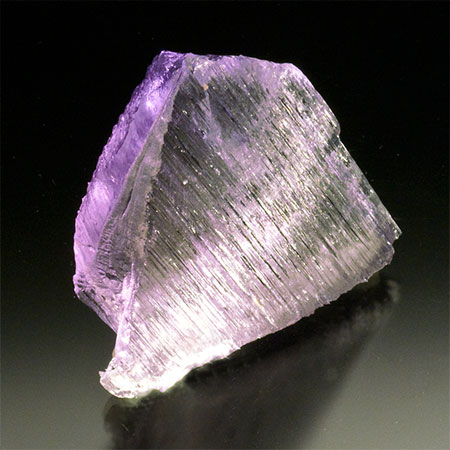 |
| Oceanview Kunzite, 6.7 x 5.8 x 1 cm. Price available upon request. Above, showing the width of the blade, and below, showing the deep lilac color down the C axis. (Photo: Jason Stephenson) |
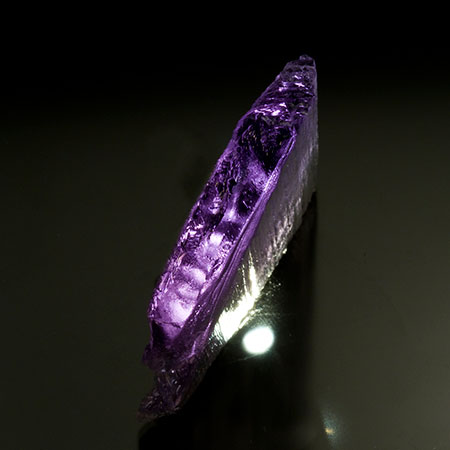 |
This month we feature an exceptional kunzite from the find in December 2010. Kunzites range from fine miniatures to potentially some of the largest ever found in San Diego County. Beautiful colors abound, including deep purples and blue greens, and some crystals are even bi-colored. We are proud to offer you some of the first specimens from Jeff Swanger and his hardworking crew up at the Oceanview Mine. Stay tuned to see the variety of material coming out of this most recent find.
Interested? Call or email us to inquire.
Visit us at the Westward Look and Tucson Gem and Mineral Show, at which we will have many kunzites directly from the mine.
See also
- “Pala District Pegmatite Opens Wide” on Palaminerals.com
- “Pala District Pegmatite Opens Wider” on Palaminerals.com
[back to top]
Mineral and Mineralogy News
From the Woman’s Club to Petroleum Club: Classy Dallas
Bill Larson speaks, peeks in Big D
Last Thursday, Pala International president Bill Larson spoke to The Dallas Woman’s Club, on the topic of “Precious Gemstones: Mined, Refined and Designed,” to an appreciative audience of nearly 400 members and guests. Seated at the club president’s table were Bill’s friends Jim and Judy Gibbs.
Jim Gibbs is a collector of fine mineral specimens and also a prominent petroleum geologist. So it’s appropriate that his passion for collecting could manifest itself in the form of an impressive display at another club in town, The Dallas Petroleum Club. After a fabulous dinner a the club, Gibbs was kind enough to show Bill Larson the specimens, which are housed in handsome cases, crafted during a recent renovation of the private downtown club.
 |
| Quite an arrangement. Judy Gibbs, far left, and Jim Gibbs attend The Dallas Woman’s Club luncheon featuring Pala’s Bill Larson as speaker. (Photo: Bill Larson) |
We asked Jim Gibbs about his collecting career. “I’ve always been a rock-freak,” he says. As a child, his family’s camping trips in Colorado mining districts provided the perfect setting for a little prospecting. “My dad could drop me off at a mine dump in the morning with a rock hammer and a sack lunch, and pick me up at dark. By then, the sandwich and cookies were gone but the sack was full of rocks.”
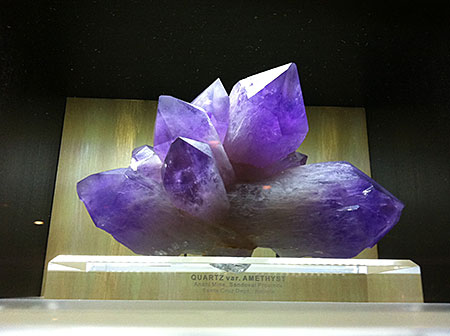 |
| Amethyst. From the Anahi Mine, Sandoval Province, Santa Cruz Department, Bolivia. (Photo: Bill Larson) |
Collecting began in earnest, he says with a wink, “when I was about six.” He bought a 100-specimen starter group from Wards Natural Science—“since 1862”—for ten dollars “and learned something of mineralogy, petrology and geography by looking at the specimens.”
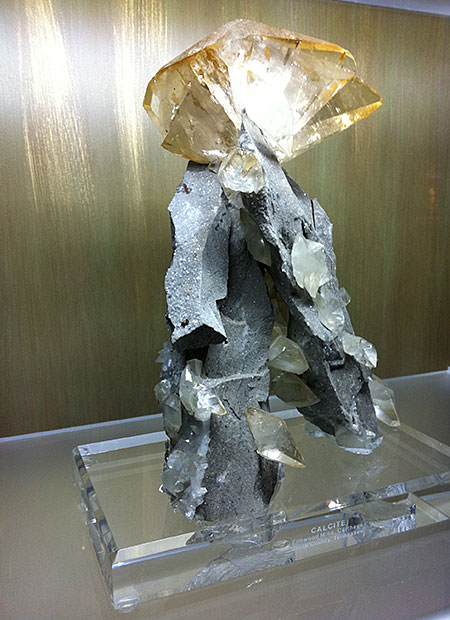 |
| Calcite. From the Elmwood Mine, Carthage, Smith County, Tennessee. (Photo: Bill Larson) |
Gibbs has collected “more intently” during the past twenty years of his more than fifty years of involvement. “I’ve collected more or less randomly, specimens that were esthetically attractive,” he says. “I’ve wanted to interest and expose others to the beauty and fascination of minerals, so I’ve tended to select specimens that were large enough to be displayed in public spaces, i.e. schools, clubs, offices, etc.” About thirty years ago, Gibbs loaned the Petroleum Club many of the specimens on display, with a little swapping and rearranging since then.
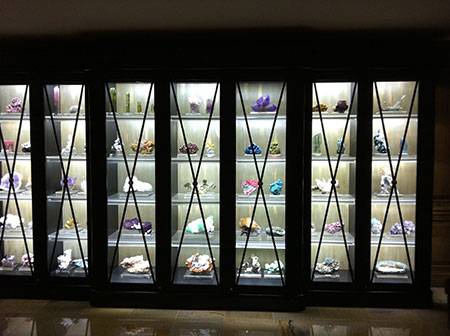 |
| Display cases, containing highlights from the collection of Jim Gibbs, at The Dallas Petroleum Club. (Photo: Bill Larson) |
A “fascinating hobby,” begun by “just enjoying the color, variety and sparkle of minerals,” has resulted in Jim Gibbs’s world class collection, some of which can be perused, virtually, in the pages of Private Mineral Collections in Texas, published by Mineralogical Record (currently on sale at a discount). He has donated many specimens to the University of Oklahoma, the University of Texas at Dallas, and the University of Texas at Austin. Show-goers can see specimens from his collection included in the “MAD” (Mineralogical Association of Dallas) case exhibits at Tucson and at Denver. Also, Gibbs has loaned gold specimens to the Dallas Museum of Art, and to the Heard Natural Science Museum in McKinney, Texas, for their special exhibits.
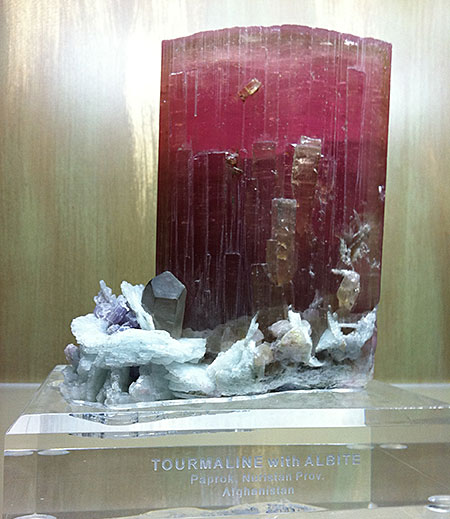 |
| Tourmaline with albite. From Paprok, Nuristan Province, Afghanistan. (Photo: Bill Larson) |
[back to top]
Going Down the Tubes
A second look at “agate fingers” from Central Java
In our last edition, we pointed our readers to Joel Ivey’s “Indonesian Fossil Bambu,” a subject Ivey began exploring after hearing about “clusters of agate tubes” in Central Java, discovered in early 2009. When we caught up with him in November, he was in the field with paleobotanist William Walton (“Walt”) Wright in search of the material’s origin. (See this profile of Wright in the June 2009 Bulletin of the Mineralogical Society of Southern California.)
According to Ivey’s January 13 update of “Indonesian Fossil Bambu,” it is Wright’s understanding that marsh or wetlands plants have just the right composition for, in Ivey’s words, “transition from living plant to stone.”
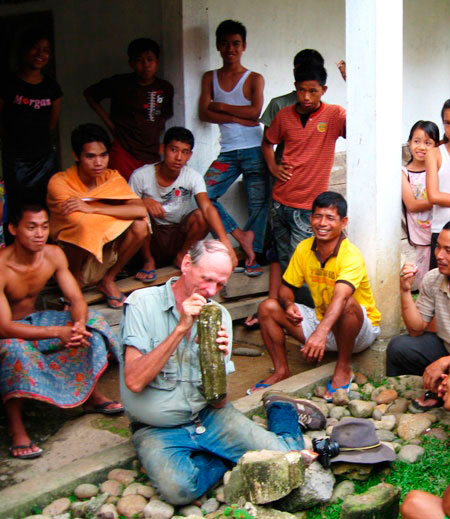 |
| Operating theater. Walt Wright examines a specimen in November, surrounded by local onlookers, in Central Java. (Photo: Joel Ivey) |
The tough, silica-rich stems of these plants “can become the nucleus for deposition of botryoidal crystallization of cryptocrystalline quartz (agate).” A cycle of volcanic ash-deposition into water, followed by evaporation, can result in crystallization of agate in layer upon layer: “fossil bambu.” (Note that this is a simplification of Ivey’s description.) It’s also Ivey’s contention that, as the original organic material decomposes, the void can be filled with “[s]uspended iron and manganese, clays and other elements”—a “bog iron” residue.
In our last installment, we pointed to hollow chalcedony stalactites from Central Java, in the Palaminerals.com catalog. Pala’s Bill Larson, who has a background in geological engineering, knows his way around fossil replacements of plant material—and also stalactites. He offers a suggestion that the agates could be “formed from an ancient dripstone formation.” And in a twist on the stem-as-template hypothesis, he told us, “Obviously [plant] life would find a way to grow in the tubes left on dripstone pieces,” accounting for the presence of organic matter in the tubes. Larson also notes the “perfectly symmetrical rounded tops” on many of the specimens, similar to masses found in cave formations, and composed of the same material—and in sizes comparable to—the “fossil bambu.” Indeed, while at the Munich show in October, Larson queried several geologists about these chalcedonies, who agreed with his assessment. “Grooves and striations along the inner walls suggest a cast or mold (Photo #7),” Ivey writes in his article, but we’re told that specimens should be examined for further evidence of pseudomorphism and fossilization.
While Larson (and others) may have a different take on the material’s formation, no one asserts that fossilization is implausible. This topic is bound to be taken up in booth-side chats at Tucson, and is sure to be the subject of follow-up by Pala International. We are grateful to Joel Ivey and Walt Wright for exposing mineral enthusiasts to a discussion of a subject that is, well, a bit off the beaten track.
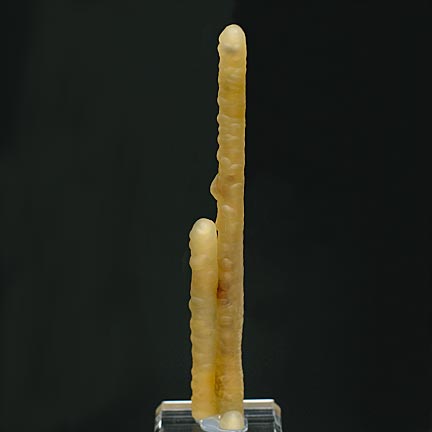 |
| Fingers. Two chalcedony stalactites with hollow center tubes. Inventory #18771. (Photo: John McLean) |
[back to top]
And speaking of stalactites…
Museum-moseyers in Denver were treated recently to an exhibition by Boulder artist Rebecca DiDomenico, titled Pellucid. The magical installation consisted of a cavern-like enclosure, complete with stalactites, stalagmites and lucent pools. What nature creates over millennia, the artist and her minions (including Balinese assistants) created during a painstaking process of two years. You see, the interior of the cave was covered with 60,000 “scales” of mica, most of which—with perhaps a pun intended—containing a single butterfly wing.
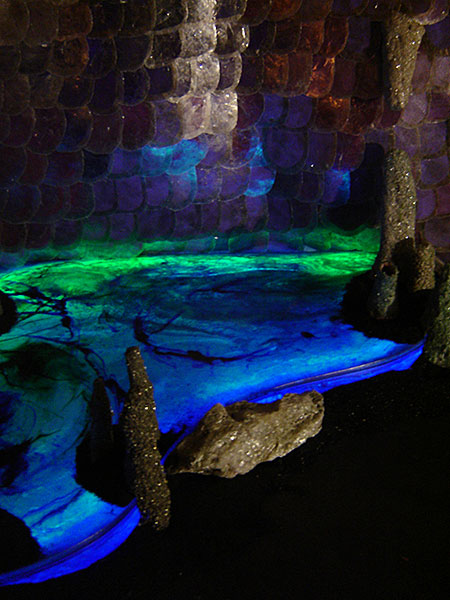 |
In an interview with the Denver Post, DiDomenico explained that she conceived of the work as a gigantic geode. But her previous work with similar media also contributed conceptually. The Veil, which she created for a traveling group exhibition of the same name (currently at Santa Clara University), uses the scales on a flexible fabric. Pellucid, she told the Post’s fine arts critic Kyle McMillan, is like “walking inside a veil,” with its undulating walls, each thin object encased in its own transparent veil. Other such connections are made in Pellucid’s slim, lovely catalog, available from the exhibition’s venue, Denver’s Museum of Contemporary Art.
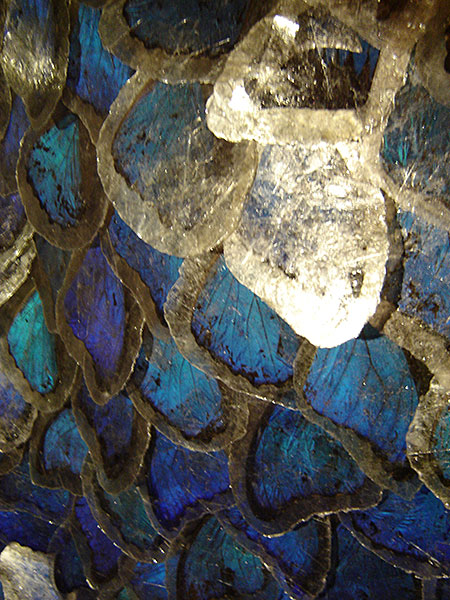 |
| Artwork: Rebecca DiDomenico, all rights reserved. Photos: David Hughes |
[back to top]
Washington Nugget the Last of Its Breed
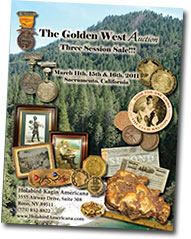 |
Ten-pound nugget to be auctioned March 16
A remarkable gold nugget was found a year ago near the mining camp of Washington, California, in Nevada County. A property owner was prospecting with a metal detector and a pick when he found the 10-pound nugget that contains 98.6 troy ounces of gold. Dubbed the Washington Nugget, it will be auctioned in Sacramento on March 15 by Reno’s Holabird-Kagin Americana. The auction catalog, pictured at right, will be available in the coming days.
The nugget was found in a section, previously unmined, of the Omega-Malakoff Channel, the famous “blue lead” Tertiary channel, according to information provided by Fred N. Holabird. In an adjacent channel, the science of hydraulic mining was invented after the area was first mined by hand in 1852. Holabird states that the Washington Nugget matches a description of characteristics discussed in The Auriferous Tertiary Gravels of the Sierra Nevada, published in 1880 by Josiah D. Whitney and W. H. Pettee. Because such nuggets were eagerly turned into ingots, the present specimen may be the last of its kind. Holabird states that he has found no such nuggets at either the Smithsonian or at the California State Collection at Mariposa.
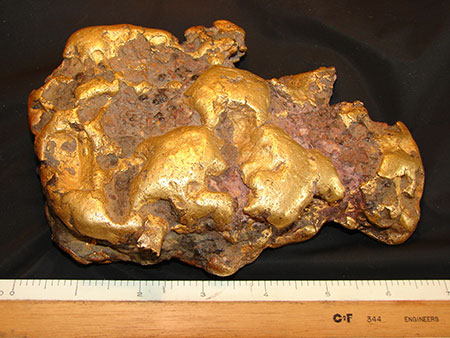 |
| The Washington Nugget is expected to fetch between $250,000 and $400,000 when it goes on the block next month. (Photo courtesy Holabird-Kagin Americana) |
More information is available at Holabird-Kagin Americana. A preview of the nugget is available to attendees of the Long Beach Expo, February 3–5, at Kagin’s Table #412. [back to top]
Books
Russian Alexandrites by Karl Schmetzer
Reviewed by Lisbet Thoresen
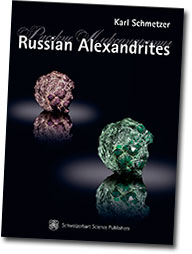 |
In September, we featured a notice regarding the impending publication of Russian Alexandrites by Karl Schmetzer (with contributions from George Bosshart, Marina Epelboym, Lore Kiefert and Anna-Kathrin Malsy). For this edition of our newsletter we thought a scholar's perspective on the volume might be interesting, so we approached Lisbet Thoresen, whose own work on gemstones, especially their historical background—discovery, naming and use—are prominent topics in this book.
The book is available from the publisher. It also is available at Tucson from Antoinette Matlins. See her here:
- AGA Conference, February 2, 8:30 a.m. – 5:30 p.m., Tucson Marriott University Park Hotel
- AGA Gala, February 2, 6:30–11:00 p.m., Tucson Marriott University Park Hotel
- Quantum Leap, booth #30, in the Galleria at the AGTA GemFair, Tucson Convention Center
 |
| Portrait of Tsarevich Alexander II on horseback. Painting by Egor Botman after Franz Krüger, ca. 1850, Hermitage Museum, Saint Petersburg. (Photo: Karl Schmetzer) |
The history of alexandrite has been shrouded in mystery and obfuscation since its discovery in the Urals, Russia, in 1833. Despite its commercial value and desirability as a rare collector gemstone, mineralogical studies on this color-change variety of chrysoberyl, especially the Russian material, have been limited until recently. In 2010, Dr. Karl Schmetzer produced a comprehensive and authoritative book on this subject entitled Russian Alexandrites. For the first time, this book reconstructs an accurate history of the gemstone through original letters and reports translated from Russian, French, Swedish and German, as well as historical photographs obtained from obscure archives. This book also provides an insight into the study of minerals of the 1830s to 1850s, when mineralogy was just beginning to become a science.
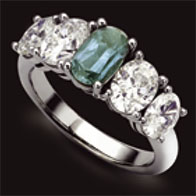 |
Ever since its discovery, access to material for study has been difficult, which may explain, in part, the paucity of mineralogical data published to date. The historical background on alexandrite, however, has been richly embroidered—from its actual date of discovery to its recognition and correct characterization as a distinctive new variety of chrysoberyl. The mining operations from the earliest ventures until the present day, likewise, have a storied history, much of it obscured under the cloak of secrecy during the Communist era.
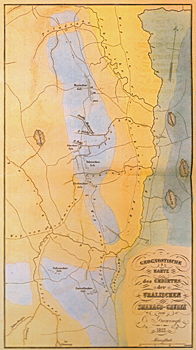 |
| The first geological map of the emerald and alexandrite mining areas north and south of the Tokovaya River was published by Grewingk in 1854. |
Marina Epelboym and Karl Schmetzer frame the story first by describing the geological setting in which chrysoberyl and alexandrite (and also phenakite) were discovered—as associated minerals in the emerald bearing zones of the Izumrudnye Kopi belt, or Tokovaya area, northwest of Ekaterinburg, which, after Colombian sources, are the most commercially significant historical emerald deposits in the world. Always regarded as a secondary mineral to emerald, Schmetzer estimates the ratio of emerald to alexandrite ranges between 100:1 and 200:1. Because the primary mining interests focused on emeralds, the history and development of the Russian mines where alexandrites were first discovered inextricably interweaves the story of alexandrite with that of some of the most important emerald specimens ever found. This aspect of alexandrite’s history is taken up in the book’s next chapter by Schmetzer.
The principal author provides a fluid narrative relating the history of the famous emeralds recovered from the Tokovaya area and their passage through the hands of illustrious collectors and museums, including the Kokovin emerald, a 400 gram emerald that was lost or stolen in 1835; the Leuchtenberg emerald druse, a group of 20 crystals en matrix found in 1831 and weighing 6265 grams (first published by von Pott in 1842); the Kochubei emerald, found in 1831 at the Sretensky Mine and weighing an astounding 2226 grams. Among the alexandrite finds, the most important ones were all discovered prior to 1840, and pre-eminent among them is a crystal group known as Kochubei’s druse (pictured below). Also in this same chapter, Schmetzer chronicles the discovery, naming and uses of Russian alexandrite in the 19th century. Named in 1842 in honor of the Tsarevich, the future Tsar Alexander II of Russia (r.1855–81), the author also presents the correspondence, publications, photographs and drawings that establish an accurate timeline and context concerning alexandrite’s early history.
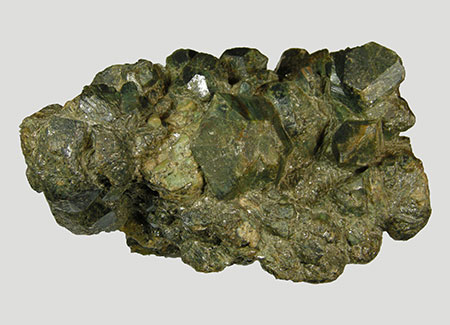 |
| The most famous and largest alexandrite crystal group ever found in Russia is known as Kochubei's druse. It was discovered in 1839/40 at the Krasnotbolotsky Mine and first described and pictured in a book by the pre-eminent Russian mineralogist and crystallographer of the 19th century, N.I. Koksharov (1862), Materialien zur Mineralogie Russlands, Vierter Band, and in a monograph by the same author in the same year, now in the Fersman Mineralogical Museum, Moscow. (Photo: Karl Schmetzer) |
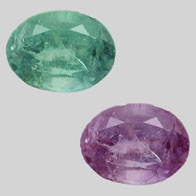 |
In 2005, the Tsar Emerald Corporation, a Canadian company, secured licensing agreements to operate the Malysheva Mine, one of the seven principal mining sites which were discovered prior to 1840. In 2007, Dr. Schmetzer and Dr. Lore Kiefert were able to visit the mine and perform the first mineralogical studies on specimens that had been unearthed after 2000 from the Malysheva Mine. As volume editor and principal author of Russian Alexandrites, Schmetzer has drawn together data gathered on alexandrites and yellowish green to yellow green chrysoberyls in various collections, both private and public, in Russia, Germany, Austria and Great Britain—covering material from a time period spanning more than 175 years. Gemological, mineralogical, morphological and colorimetric data are presented in separate chapters, each detailed and copiously illustrated with color plates, photomicrographs, spectra, schematic diagrams, plots and charts.
Chapter 6 presents gemological and mineralogical studies performed by Schmetzer and Kiefert, which employed analytical tools, including electron microprobe, SEM-EDX, energy-dispersive X-ray fluorescence (EDXRF) and micro-Raman spectroscopy in order to obtain quantitative data and corroborative identification of inclusions. Numerous photomicrographs complement the discussion of alexandrite’s inclusions, distinctive growth structure and twinning.
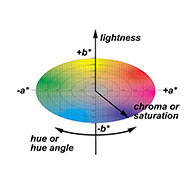 |
| General outline of the three-dimensional CIELAB color space with parameters shown for hue, hue angle and chroma. (Artwork: Karl Schmetzer) |
Beginning with a discussion of the early work of mineralogists on the recent finds from the Central Urals, in Chapter 5, Schmetzer presents an in-depth examination of the morphology and twinning in chrysoberyl and especially alexandrite, elaborating in detail the distinctive habit of single crystals, single contact twins and cyclic twins or trillings. Numerous drawings by the author and photographs of historical specimens illustrate the discussion on the morphological variations of crystals originating from the Tokovaya area.
Chapter 7 is devoted to an investigation into the nature of chatoyancy in alexandrites and chrysoberyls from different gem-producing regions of the world, as well as the rare phenomenon of asterism in chrysoberyl from Sri Lanka—a subject that has received scant attention previously. Chapter 8 compares the growth patterns of natural alexandrite and its synthetic counterpart. The last chapter, authored by Anna-Kathrin Malsy, discusses origin determination and the use of several analytical tools, primarily laser ablation inductively coupled plasma mass spectrometry (LA-ICP-MS) to obtain trace element chemistry in specimens from Russia; Hematita, Brazil; India; Sri Lanka; and Lake Manyara, Tanzania. Operating conditions and data acquired are described and characteristic features useful for making separations are discussed. This chapter, featuring ternary diagrams and plots, is a useful benchmark for future studies on chrysoberyls and alexandrites from other localities.
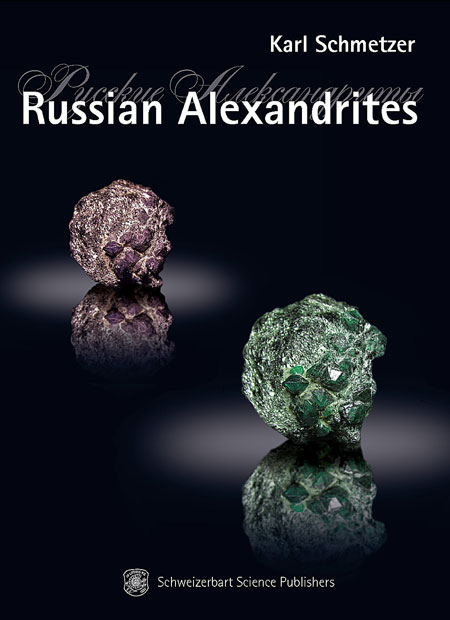 |
| On the cover. Alexandrite crystal group shown in both daylight and incandescent light; this extraordinary piece was submitted to the Gemmological Laboratory, Liechtenstein for examination in 2009. The sample measures about 8 x 9 cm. (Photo: Th. Hainschwang.) |
This volume aims to be a handy reference as much as it aims and succeeds at being a meticulously detailed and comprehensive work on Russian alexandrite: the Appendices and Timetable feature tables on primary mining localities, physical data on alexandrite and green chrysoberyls, English-German transcription of significant names and milestone events. The achievement of this book is not only its exhaustive treatment of the subject, unprecedented for the scope and detail presented, but also its historicity. It is a fascinating chronicle of alexandrite’s Russian origin and labyrinthine odyssey through time—a painstakingly researched story replete with intrigue, tragedy and epochal sweep worthy of translation to motion pictures. Such a rare and special gemstone deserves no less than the able and thorough treatment it receives in this book.
Lisbet Thoresen is an independent scholar specializing in gemological and archaeometric studies on gems of the ancient world. Previously, she was Associate Conservator of Antiquities at the J. Paul Getty Museum, where she worked on all aspects of the preservation, analysis, authentication, and conservation of the collection, including glyptic art (carved gems). She is volume editor and principal author for the book (forthcoming), On Gemstones: Gemological and Analytical Studies of Ancient Intaglios and Cameos.
[back to top]
Terra Spinel – Terra Firma
by Vladyslav Y. Yavorskyy
with Richard W. Hughes
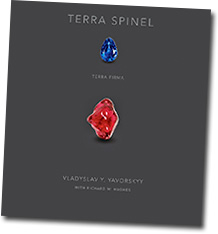 |
Overlooked gemstone receives sumptuous study; also available at Tucson
Pala International has long appreciated the beauty of fine spinels. The Palaminerals.com catalog contains twenty specimens, from pink to red to lustrous black.
Last August we featured a rare 11.18-carat red spinel from Burma, cut from its original 15.81 carats. A few months earlier we were enchanted by a rich and rosy 22.76-carat spinel from Tajikistan, with some intriguing inclusions. In 2007, we offered a variety with “the base hue of a fine amethyst, the slight color shift of a sapphire, and the diagnostic dispersion.” We then quoted from Gübelin & Koivula: “In many respects, spinel is an ideal gemstone.”
Strange then, how award-winning gemologist and author Richard W. Hughes, in his announcement of a new monograph on the stone, would remark, “And yet few know its name and fewer still understand its importance. This is truly a tragedy….” We now can put all of that in the past tense.
Terra Spinel – Terra Firma is a new book by Bangkok-based dealer Vladyslav Y. Yavorskyy, with the aforementioned Richard Hughes. Our personal copy, we’re told by Mr. Hughes is on a slow boat from China—literally—as he now resides in Hong Kong. The contents have nonetheless been sampled in tempting helpings at SpinelBook.com. When we spoke with Hughes prior to his announcement he was quite enthusiastic about the book’s quality: 200 hardbound pages of six-color process printing, with spot varnish giving the gemstones a special sparkle. But then, many of you already have sprung for a copy in the big tent at Tucson’s GJX Show, booth 404, 504.
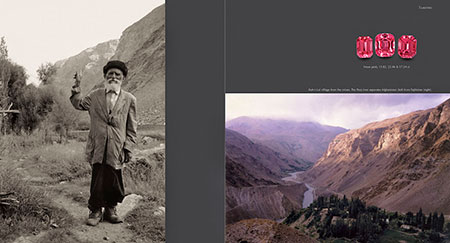 |
| Two pages from the Terra Spinel chapter on Tajikistan, including the neon-pink variety, similar to that which we featured last March. (Image courtesy Vladyslav Yavorskyy) |
[back to top]
— End February Newsletter • Published 2/2/11 —
